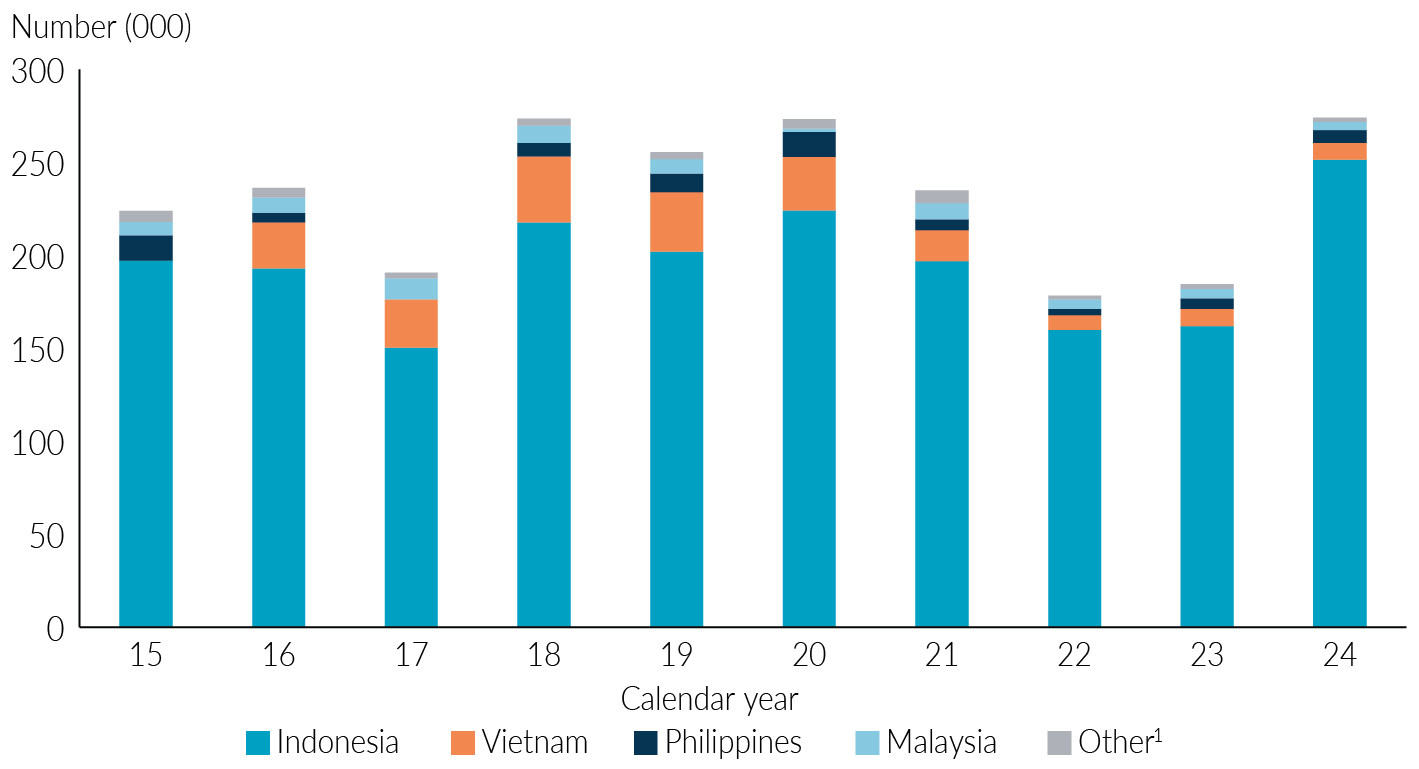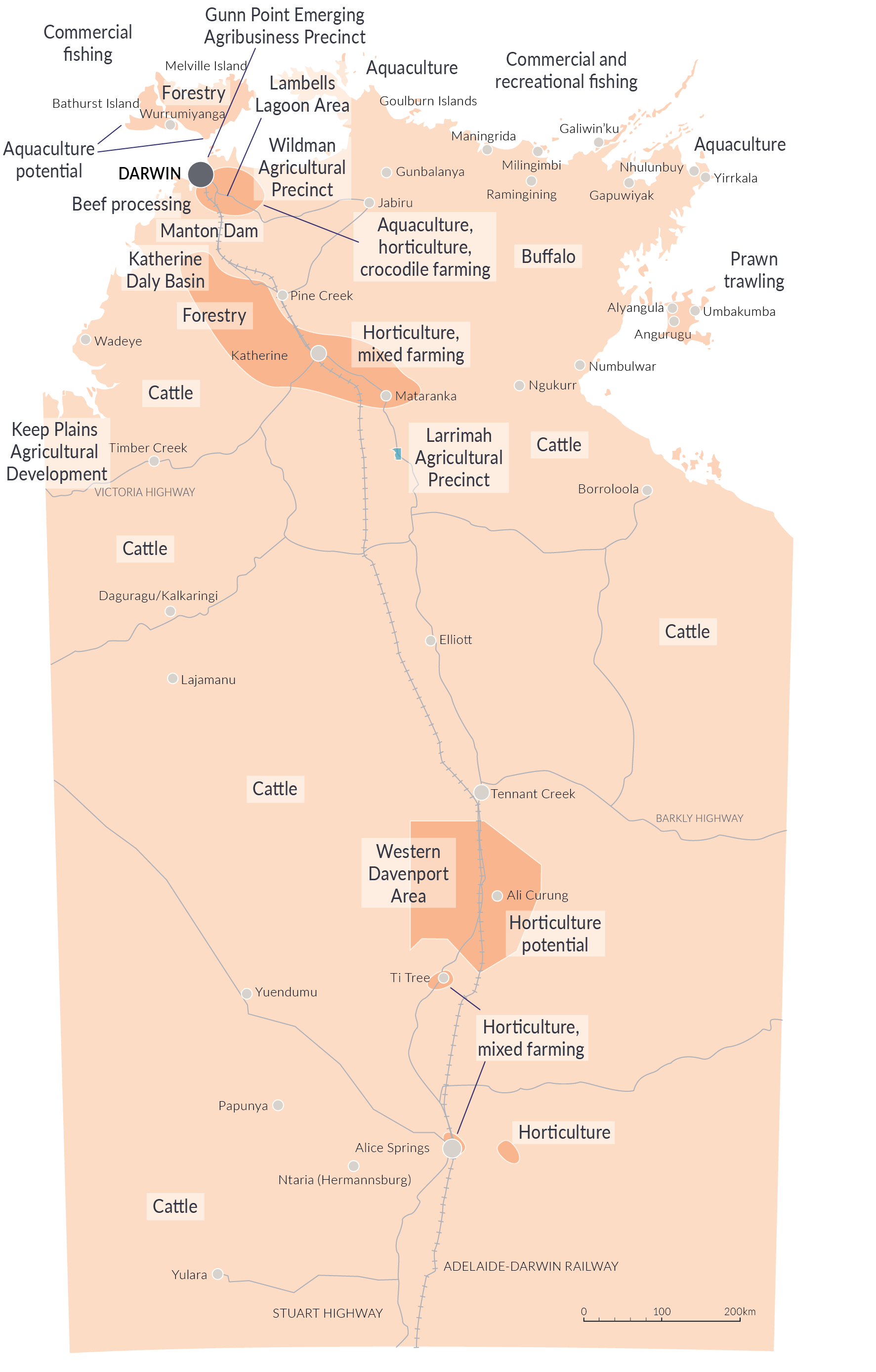Agriculture, forestry and fishing
Outlook
The value of the Territory’s agricultural sector is expected to grow in 2024-25 due to investment and herd building in the cattle industry. In the medium term, the sector will be supported by several large agricultural land developments.
In 2023-24, the agriculture, forestry and fishing sector accounted for 3.4% of GSP in the Territory, having increased by 9.9% to $1.4 billion. The sector accounts for 2.1% of total employment, with around 2,900 workers employed on average, noting there are significant seasonal fluctuations. Current growth in the sector is largely due to increased cattle production, diversification into cropping on pastoral leases, and investment in new cropping and horticultural developments (Map 4). In the medium term, growth is expected to be supported by several large agricultural land developments, along with significant private sector investment in property purchases, and growth in exports.
Live cattle
The Territory’s live cattle exports increased by around 42% in 2024, driven by increased demand from Indonesia and favourable weather conditions (Chart 15). The recent acquisition of several large cattle stations in 2024 reflects increased investment in the sector that should support future supply.
Chart 15: Annual number of live Territory cattle exports, by destination
1Other comprises Brunei, Cambodia, Egypt, Timor-Leste and Thailand.
Source: Department of Agriculture and Fisheries
Net interstate trade of Territory cattle has grown over the past year, with the number of Territory cattle moved interstate increasing by around 65%, while the number of interstate cattle moved into the Territory declining by around 28%.
Indonesia accounted for around 91% of the Territory’s live cattle exports in 2024. Indonesia’s geographical proximity, constraints around herd development, established diplomatic relations with Australia, and strong demand, sees it as the largest and most consistent buyer of northern Australian live cattle. Currently, Australia is Indonesia’s sole provider of live cattle although the Indonesian Government is seeking to diversify supply, with new regulation that will allow cattle imports from countries such as Brazil.
Although domestic supply remains high, the price of live cattle from Darwin has increased from last year, up 10 cents to $3.60 per kilogram in March 2025. If this upward trend in price persists, it may place downward pressure on demand for Australian live cattle. The tariff announcements by the US administration in April 2025 introduced volatility in the cattle market, which may lead to changes in trading relationships potentially opening up new opportunities for Australian cattle meat exports. Foot and mouth disease and lumpy skin disease, which have been detected in Southeast Asia, continue to be a significant biosecurity threat to Australia’s cattle industry and an ongoing risk to live cattle exports.
The Territory’s live buffalo exports declined in 2024, with the number of live buffalo exported declining 26% lower compared to last year. This market experiences significant fluctuations due to change in supply conditions across Asia (particularly from India). The Territory currently exports live buffalo to Indonesia (accounting for around 76% of the Territory’s exports), Brunei, Sarawak and Vietnam. Live buffalo is typically a cheaper alternative to live cattle, although this is constrained by wild harvest supply.
Other livestock products
According to data from the Commonwealth Department of Agriculture, Fisheries and Forestry, overseas boxed beef exports from the Territory recovered from no production in 2023 to 247 tonnes in 2024. Domestically, the number of Territory cattle sent interstate for meat processing declined by around 15% to 26,200 due to increased restocking by cattle producers.
There are several micro-abattoirs in the Territory and a single larger facility at Batchelor, which produces both frozen and fresh boxed beef and buffalo, along with the capability for a full suite of offals. The Territory currently exports processed beef and buffalo products to Vietnam, South Korea, the Philippines and Japan.
Australia accounts for 61% of the global trade in saltwater crocodile skins, with most being farmed and exported by the Territory. Gross revenue from the Territory crocodile industry increased by around 40% to $46 million in 2023-24, largely reflecting increased production capacity.
Map 4: Territory agriculture, forestry and fishing1
1This map is produced from various sources. Department of Treasury and Finance cannot guarantee the accuracy, currency, or completeness of the information.
Source: Department of Treasury and Finance; Department of Agriculture and Fisheries
Horticulture
The outlook for horticultural production is expected to remain positive over the forecast period, with several potential developments in the outer years.
Mango production accounts for a large proportion of the Territory’s horticulture sector and is strongly influenced by seasonal conditions and demand in southern Australian markets. In 2024‑25, the Territory mango industry produced around 52% of the nation’s supply. Territory mango production is expected to increase over the medium term with three new varieties of mango (named Yess!, AhHa! and Now!) introduced in 2023‑24. The new varieties are a product of the National Mango Breeding Program and could potentially extend the Territory’s mango season. Around $3.4 million worth of Territory mangoes were exported overseas in the 2024 calendar year to countries including New Zealand (around 50% of the Territory’s exports), Canada, United Arab Emirates, Singapore, and the US.
Melon farming is the second-largest horticultural activity after mangoes in the Territory, producing around 23% of the nation’s supply. Current production includes watermelons, pumpkins, rock melons and honeydew melons. Melon production is expected to increase over the medium term, supported by recent investment and expansion plans from major producers.
Horticultural producers of crops such as jack fruit, dragon fruit and citrus are maturing and developing production and supply chain systems to benefit from the Territory’s seasonal advantage. Dragon fruit production in the Territory has fallen due to increased competition from Vietnamese imports over the past five years. This is pushing dragon fruit producers to seek export market opportunities. New plantings of citrus crops are expected to come into production over the outlook period after the Territory was declared citrus canker free in 2021.
Broadacre crops
In 2023-24, around 13,000 hectares of cotton was grown in the Territory, with 50,000 bales produced over the year. Production is expected to significantly increase over the outlook period, reaching $250 million per annum within 10 years. The Territory’s first cotton gin opened in Katherine in December 2023, allowing famers to process their cotton locally, rather than being trucked interstate for processing and export. In September 2024, a shipment of Territory cotton was exported from the new gin via Darwin Port.
Irrigated and rainfed hay and fodder production remains a core diversification option for pastoralists with off farm sales worth $34.6 million in 2023. New cereal and grain production is likely to emerge as producers seek rotation crops for cotton and hay.
Forestry
The outlook for the forestry industry is generally positive, noting the longer-term nature of activity means the economic return takes many years to realise. There are currently 42,000 hectares of plantations in the Territory, with a standing value of $115 million. However, production from the Indian Sandalwood plantations is less certain following the recent sale of several properties, which will be converted to melon production. The African Mahogany plantations in the Douglas Daly region are expected to reach maturity in 2026-27.
Fisheries
Wild harvest production in 2023-24 was slightly below 5,000 tonnes, a decline of around 790 tonnes compared to 2022-23. The gross value of production from wild caught product also declined to $47.5 million.
Inshore fisheries (including barramundi, mud crab and aquarium products) had reduced production in 2023‑24. The cyclone in the Gulf and the sale of several commercial licences impacted mud crab fishery productivity and overall production. The Barramundi Fishery saw fewer vessels in operation, with catchment effort caps in place for selected locations. In contrast, the Coastal Line, Trepang and Aboriginal Coastal fisheries reported increased production.
Offshore fisheries, including Demersal, Timor Reef, and Spanish Mackerel, reported a drop in production, largely due to fewer vessels in operation. The Offshore Net and Line Fishery reported a 50 tonne increase in production in 2023-24 compared to 2022-23.
The gross value of aquaculture production contracted slightly to $77 million in 2023-24, reflecting a slight decline in the value of pearling aquaculture although barramundi aquaculture production continued to grow. The outlook for the Territory aquaculture industry is positive, with several new species being investigated. The Commonwealth’s introduction of country-of-origin labelling for seafood in the hospitality sector is expected to increase consumer awareness and preference for Australian seafood products.
Territory Government agribusiness development
There are several development opportunities and facilitated projects underway focusing on growing the agriculture, forestry and fisheries sector in the Territory. Priority projects include Larrimah Agricultural Precinct, Wildman Agricultural Precinct, the proposed Ord River Irrigation Scheme expansion into the Territory (Sweetwater Agricultural Development Project), an improved regional road network and developing infrastructure to increase export opportunities.
Land developments
There has been significant progress over the past year toward the development and delivery of the Wildman Agricultural Precinct, Larrimah Agricultural Precinct, and Sweetwater Agricultural Development Project as part of the Territory Government’s land releases. All projects now have proponents in place to deliver a range of agricultural products, which will drive regional growth in the sector. The Department of Agriculture and Fisheries continues to support these developments through land suitability assessments, advice on land tenure, regulatory approvals processes, and assisting with stakeholder engagement.
In July 2024, the Commonwealth provided $2.3 million to develop a detailed business case for the proposed Ord River expansion to the Northern Territory, through the National Water Grid Fund. This project will assess infrastructure options to expand the Ord River Irrigation Scheme to supply water from Lake Argyle in Western Australia to the Sweetwater Agricultural Development Project in the Territory.
The Territory Government is also currently working to identify additional regional areas that could be developed for agriculture. Prospective precinct areas such as the Western Davenport, including Singleton Station, could potentially produce up to 150,000 to 200,000 tonnes per annum of various crops, with the project currently undertaking regulatory approvals. Several other areas are also being investigated including the Douglas Daly, Gunn Point, and Lambells Lagoon regions, with opportunities being investigated in all three areas.
Collectively, these developments provide an opportunity to significantly expand and diversify the Territory’s agricultural production area and offer opportunities for new investment in a wide range of high value crops, including mangoes, melons and forestry, as well as broadacre crops such as cotton, sorghum and chia.
For the latest data on the agriculture, forestry and fishing sector, refer to the Territory Economy website.


